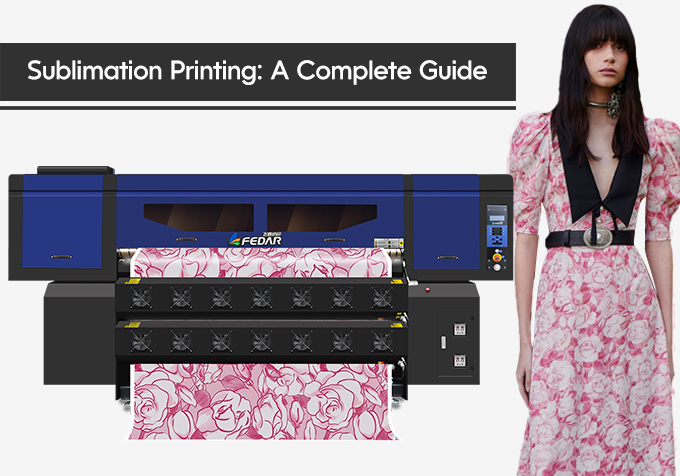24
Jul
Have you ever wondered how a lifelike image on a coffee mug or a lustrously colored design on a t-shirt is printed? It's not "magic" but a cutting-edge printing technique popularly known as sublimation. You can achieve these vibrant, long-lasting, and realistic designs, too, only if you know how to do it rightly.
And in this complete guide, we'll walk you through the entire process. We'll cover every single "what" and "how" you need to know about sublimation printing. From the process itself to its pros and cons and what you can sublimate on, you'll find all of your questions answered.

The strange-looking name might make the process seem tricky and techy, but it's much simpler to understand than you'd think.
"The simple definition of sublimation: When a solid material turns into a gas without going through the liquid stage, it is called sublimation."
In simple words, sublimation printing is a digital printing method that uses high heat and pressure to transfer designs (inks) onto materials such as polyester, vinyl, metal, ceramic, and a lot of other rigid substrates.
It's a permanent, heated-based method that gives high-definition, sharp details and full-color prints that are crack or fade-resistant.
Design: The first step in this printing method is to create (imagine) a design that will be transferred onto the substrate. This can be done by hand or in an easy way by using graphic software like CorelDRAW or Adobe Photoshop.
Its Printing Time: Once you have your design ( idea), the next step; print it. For this, you will need a sublimation printer. A converted inkjet printer may also work. It uses sublimation ink to print the design onto a transfer paper.
The Pros of Sublimation Printing:
One of the most exciting upsides of sublimation printing is its ability to produce vibrant and detailed prints. The high temperatures used in the process result in sharp, clean lines and vivid colors that won't fade over time.
As we said earlier, this method is permanent; it creates prints that are fade and crack-resistant. Even after going through multiple washes, your designs will stay intact. Plus, you can print any color as the sublimation ink can produce limitless shades and colors.
When it comes to the selection of materials, sublimation printing gives you a lot of freedom. You can print on fabrics like polyester, nylon, or spandex. You can also print on rigid surfaces like mugs, covers, or something else.
The quick turnaround time is another plus point that makes sublimation printing a popular method. Everything is done digitally, which means there's no need for screens or plates. You can print a design right away without any prep work; all you need is a PC, printer, heat press, and the materials.
The last upside of sublimation printing is that it's a planet-friendly solution. Unlike other processes that use solvents or water-based inks, it uses dry inks. This type of ink is clean; it produces less (almost no) waste.
The fact is that sublimation printing is not immune to error. Like any other form of printing, it has its own set of drawbacks; below, we've listed 3 of the major ones.
Keep in mind that sublimation printing only works on 100% polyester or fabric blends that contain a high polyester percentage. While it is feasible to sublimate on other materials like silk, the design will not be enduring.
Another issue with sublimation printing is the possibility of white creasing. It occurs when the fabric or transfer paper is not fully flat during the printing process. The result: white streaks or gaps in your printed design.
White or light-colored fabrics are excellent for doing sublimation printing. With dark or black alternatives, though, it is less effective. The reason is simple: white ink does not exist in sublimation inks, nor can they lighten the base color.
T-shirts, hoodies, sweatshirts, socks, and much more; the possibilities are endless. Sublimation printing is perfect for creating personalized clothing, whether it's for yourself or for your business.
Sublimation printing allows you to add vivid designs to a variety of home decor products, like blankets, cushions, and curtains. You can even design your own tablecloths, wall hangings, or rugs.
Sublimation printing is a well-known method for creating promotional items like mouse pads, phone cases, flags, banners, and much more; it's a great way to advertise your brand or business.
Whether it's "His & Hers" mugs, personalized photo frames, or custom keychains, sublimation printing allows you to create unique and thoughtful gifts that are sure to make an impression.
Every printing process requires certain equipment to work correctly. Sublimation printing is no different. If you're planning to invest in sublimation, make sure you have the right tools for the job. These include:
A sublimation printer
Heat press machine
Sublimation ink & paper
A computer with design software
Protective gear (like gloves or masks)
As previously stated, sublimation printing works nicely on 100% polyester or blends with high polyester. When choosing the materials for your projects, bear this in mind. In order to prevent white creasing, ensure the surface you are printing on is not folded.
Before you go all out with your designs and materials, make sure to do a few test prints. You can do one or even multiple times to ensure that your design translates well onto the chosen material. This will help you identify any potential issues and make necessary adjustments before moving on to the final product.
To make a long story short, sublimation printing is all about color, versatility, & creativity; it's a fantastic way to turn your ideas into reality, make unique items, and bring out your artistic side.
With its endless possibilities and relatively easy process, everyone can become a sublimation printing pro with a little practice and some trial and error. Just stick to the guidelines, be creative, and you'll be on your way to creating crisp, clear, and vibrant designs with sublimation printing.
If there's anything we can do to further showcase machines' features, please let us know.
Email: sale@fedar.net
Whatsapp: +86 15515715397
Our company has over 30 models of printers with independent intellectual property rights and patents. Marketed under the esteemed brands of Skycolor, Stormjet, and Fedar brands, these printers cover a wide range, including digital textile printers, UV printers, eco-solvent printers and more. Known for their exceptional quality and performance.
